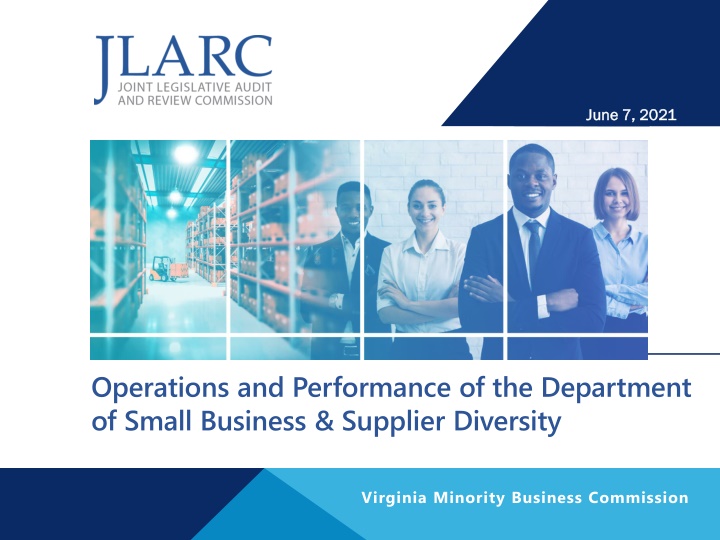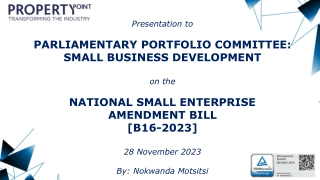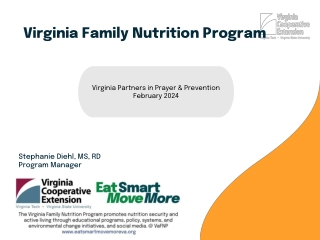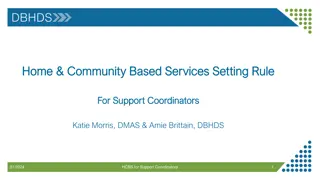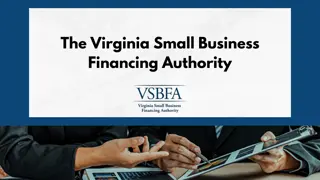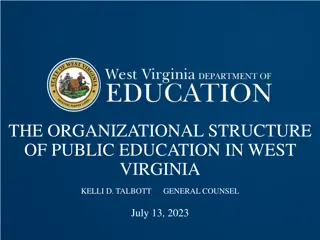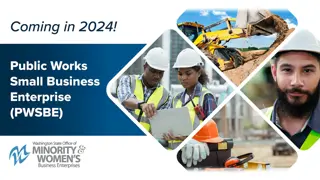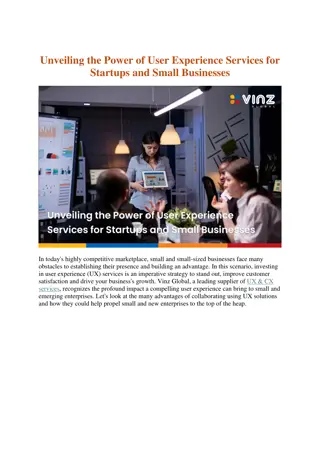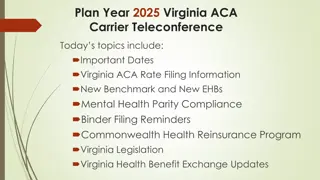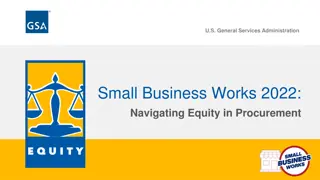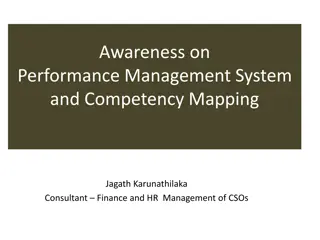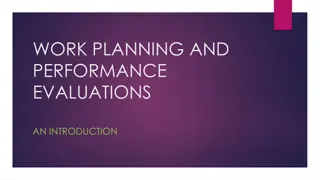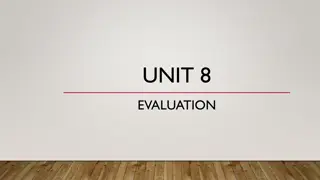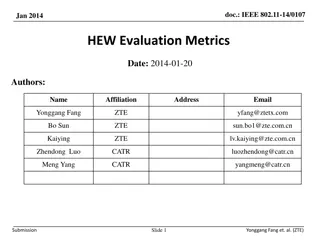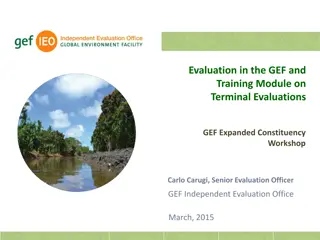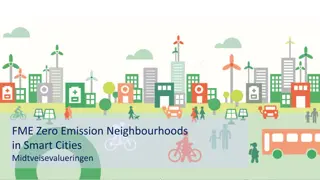Performance Evaluation of Virginia SBSD and Growth Support for Small Businesses
In this presentation, the operations and performance of the Department of Small Business & Supplier Diversity in Virginia are reviewed. The study mandate includes assessing agency staffing, spending, and management efficiency, comparing small business definitions, and determining program effectiveness. Research activities involve interviewing staff and experts, analyzing data on certification and financing, and surveying businesses. SBSD supports small, women-, and minority-owned businesses through certification, financing, and business assistance services. Responsibilities include achieving SWaM goals and certifying various types of businesses.
Download Presentation

Please find below an Image/Link to download the presentation.
The content on the website is provided AS IS for your information and personal use only. It may not be sold, licensed, or shared on other websites without obtaining consent from the author.If you encounter any issues during the download, it is possible that the publisher has removed the file from their server.
You are allowed to download the files provided on this website for personal or commercial use, subject to the condition that they are used lawfully. All files are the property of their respective owners.
The content on the website is provided AS IS for your information and personal use only. It may not be sold, licensed, or shared on other websites without obtaining consent from the author.
E N D
Presentation Transcript
June 7, 2021 June 7, 2021 Operations and Performance of the Department of Small Business & Supplier Diversity Virginia Minority Business Commission
Study mandate Review the Department of Small Business and Supplier Diversity (SBSD) evaluate agency staffing, performance, spending, and management, including the VSBFA*; assess efficiency and effectiveness of programs; and compare Virginia s small business definition to federal and other state definitions. *VSBFA = Virginia Small Business Financing Authority JLARC 2
Research activities Interviews (100+) SBSD staff Virginia business groups Other states & subject matter experts Data analysis Certification & financing timeliness, accuracy, decisions Size of Virginia businesses Surveys SBSD staff State agencies Businesses that use SBSD services JLARC 3
In this presentation Background Business certification Business assistance SWaM goal & plans JLARC JLARC 4
SBSD supports growth and competitiveness of small, women-, and minority-owned businesses SBSD created in 2014 (merging DBA and DMBE) SBSD has 40 staff and budget of ~$7M SBSD supports businesses primarily through: Certification Small business financing Business One Stop website Business assistance (e.g., counseling and events) DBA = Department of Business Assistance DMBE = Department of Minority Business Enterprise JLARC 5
SBSD has responsibilities related to states SWaM goal & small business definition JLARC 6
In this presentation Background Business certification Business assistance SWaM goal & plans JLARC JLARC 7
SBSD certifies businesses, most of which are small, micro, minority-owned, or women-owned Certification Certification # certifications # certifications (2019) (2019) 10,486 6,058 3,843 3,616 2,493 % certifications % certifications (2019)* (2019)* 40% 23% 15% 14% 10% Small Micro Minority-owned Women-owned Other** *Numbers do not sum because of rounding. **Other includes = disadvantaged business enterprises (DBE); service-disabled veteran-owned businesses, and employment service organization JLARC 8
Previous findings SBSD s business certification process was timely and generally resulted in accurate certification determinations, but considerable follow up was required for many applications. Appeals process was not available to new business applicants, and some businesses were confused about the process. JLARC JLARC 10
SBSD processed certification applications much faster than in 2017 JLARC 11
Certification determinations were mostly accurate 99 percent of ~10,500 certified small/micro businesses met size requirements 27 certified micro businesses mistakenly approved because of staff confusion over size requirements Several process elements help ensure accuracy: Multiple documents required to prove eligibility Management staff review all denied SWaM applications; subset of approved SWaM recertification process streamlined, but updated tax documents required JLARC 12
SBSD staff often needed to follow up with businesses to request more application information ~17,000 follow-up requests for 10,000 applications (2019) Multiple businesses commented on lack of clarity about required information and extent of follow up More precise instructions about the documents and information needed would be helpful. (Business) Some certification entities encourage businesses to participate in precertification meetings/webinars to clarify application process JLARC 13
Appeals limited to recertifications, and some businesses were confused by process Appeals process was limited to SWaM businesses denied recertification; those denied new certification cannot appeal Limitation intended to manage staff workload Relatively low number (< 5 percent) of all SWaM applications denied Some businesses confused about reasons they can appeal and difference between an appeal and waiver Waiver limited to applicants whose certification was denied and have new information to provide JLARC 14
Recommendations SBSD should post precertification webinars or videos online describing the certification application process. *Implemented by SBSD SBSD should provide right of appeal to all SWaM applicants that believe SBSD made a mistake in denying their application. *Implemented by HB 2172, 2021 session SBSD should clarify its appeals process by revising denial letters and adding information to its website about the (i) grounds, (ii) processes, and (iii) required documentation for an appeal vs. waiver. JLARC JLARC 15
In this presentation Background Business certification Business assistance SWaM goal & plans JLARC JLARC 16
SBSD provides assistance directly to businesses to help them develop and grow SBSD has team of regionally-based staff to provide direct assistance to businesses Three types of assistance services provided: Group events One-on-one counseling sessions Scaling4Growth JLARC 17
Previous finding SBSD s business assistance events and counseling sessions were helpful to businesses, but use was hindered by lack of awareness and accessibility. JLARC JLARC 18
SBSD should improve marketing and accessibility of business assistance services Over half of businesses surveyed said they had not participated in events or counseling sessions because lack of awareness Marketing efforts were ad hoc and varied by region Experts emphasize importance of making business assistance services available in a variety of platforms JLARC 19
Recommendation SBSD should improve awareness of and accessibility to its business assistance events and counseling sessions through (i) developing and implementing a coordinated written marketing plan and (ii) providing on-demand written materials and recorded webinars on its website. JLARC JLARC 20
In this presentation Background Business certification Business assistance SWaM goal & plans JLARC JLARC 21
Governor, agencies, and SBSD each play a role in state s SWaM initiatives JLARC 22
Previous finding Executive branch spending with SWaM-certified businesses was substantial and benefited certified businesses. JLARC JLARC 23
SWaM program helped certified businesses win state contracts Agencies procured over $2 billion through SWaM- certified businesses (FY19) Purchases with SWaM-certified businesses increased ~15% over last five years Median sales increased ~20% for businesses after SWaM certification Businesses reported non-monetary benefits of SWaM certification (e.g., improved image) JLARC 24
Previous finding Agencies abilities to meet the governor s 42% SWaM goal varied, and majority reported difficulty achieving the goal. JLARC JLARC 25
State agencies SWaM spending ranged from 4 to 87 percent; majority did not meet the goal JLARC 26
Achieving SWaM goal was strongly impacted by each agency s unique procurement needs Asking each agency to meet the same 42% SWaM goal does not account for key factors Some goods/services agencies purchase generally not offered by many SWaM-certified businesses Example: specialized research materials Number and size of procurements highly variable for some agencies JLARC 27
Policy option Governor could direct each state agency to set an ambitious, but achievable, SWaM goal that accounts for (i) availability of SWaM-certified businesses and (ii) agency s ongoing and upcoming procurements. JLARC JLARC 28
Previous finding SBSD was fulfilling its required role in the SWaM plan process but had not given agencies meaningful feedback on their plans. JLARC JLARC 29
SWaM planning process had not historically helped agencies find workable strategies to meet SWaM goal SBSD held meetings with different group of agencies each month to discuss SWaM performance SBSD collected agency SWaM plans but did not regularly review plans or provide feedback Majority of agencies surveyed disagreed (or had no opinion) that SWaM plan is helpful JLARC 30
Recommendations Governor should amend E.O. 35 (2019) to direct SBSD to implement a more meaningful SWaM planning process focused on strategies and substantive interactions between SBSD and agency staff. SBSD should identify effective strategies for increasing SWaM spending and provide agencies with guidance on how to implement them. JLARC JLARC 31
Questions? / Comments? Justin Brown, Senior Associate Director Lauren Axselle, Project Leader JLARC JLARC http://jlarc.virginia.gov/ http://jlarc.virginia.gov/ (804) 786 (804) 786- -1258 32 1258
